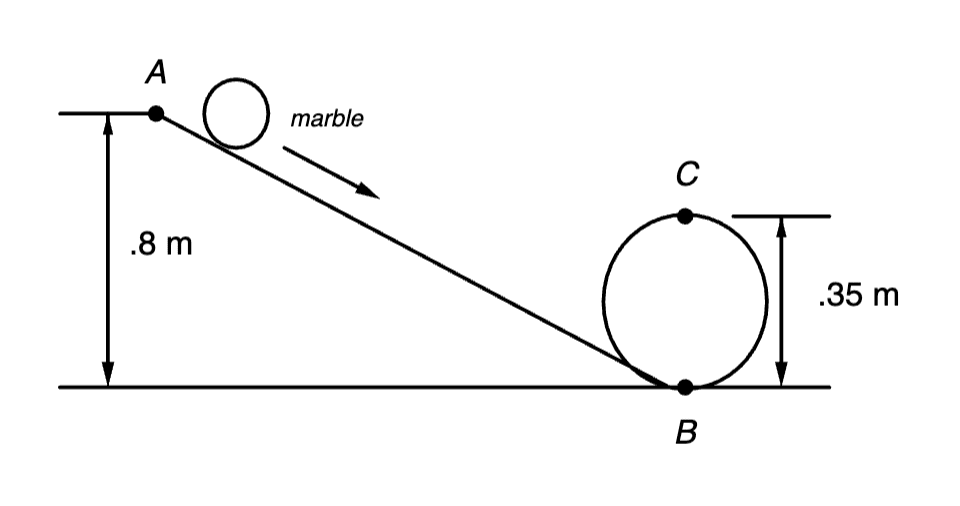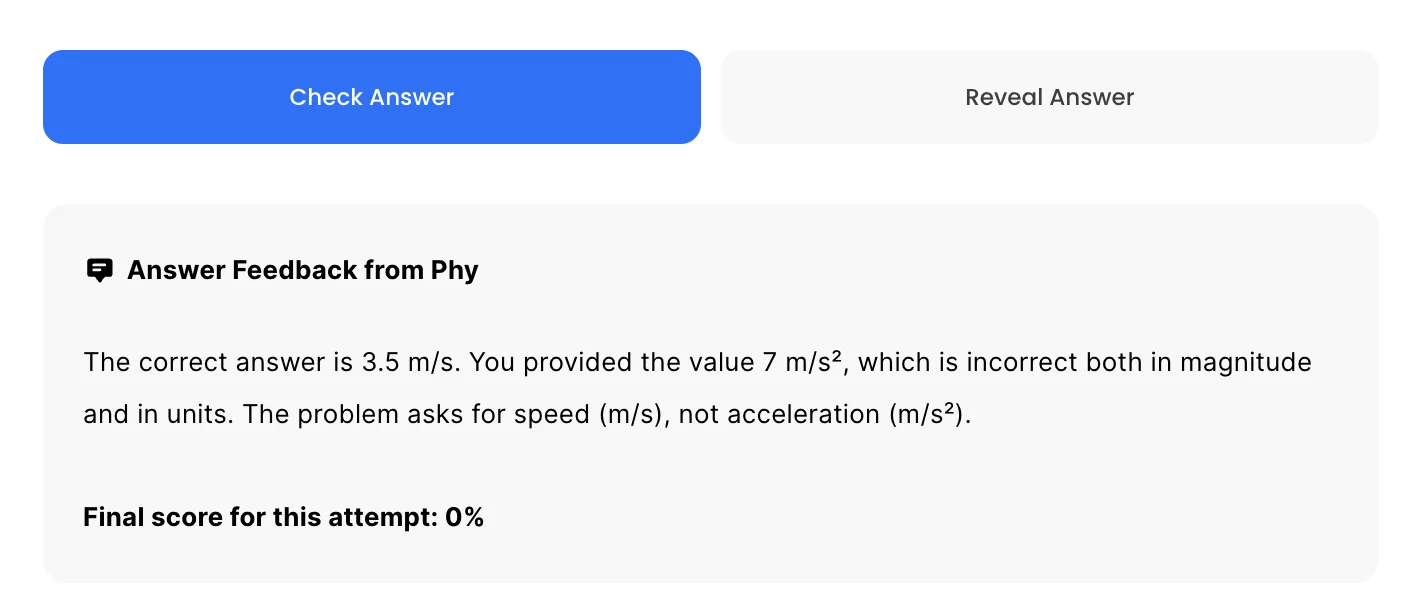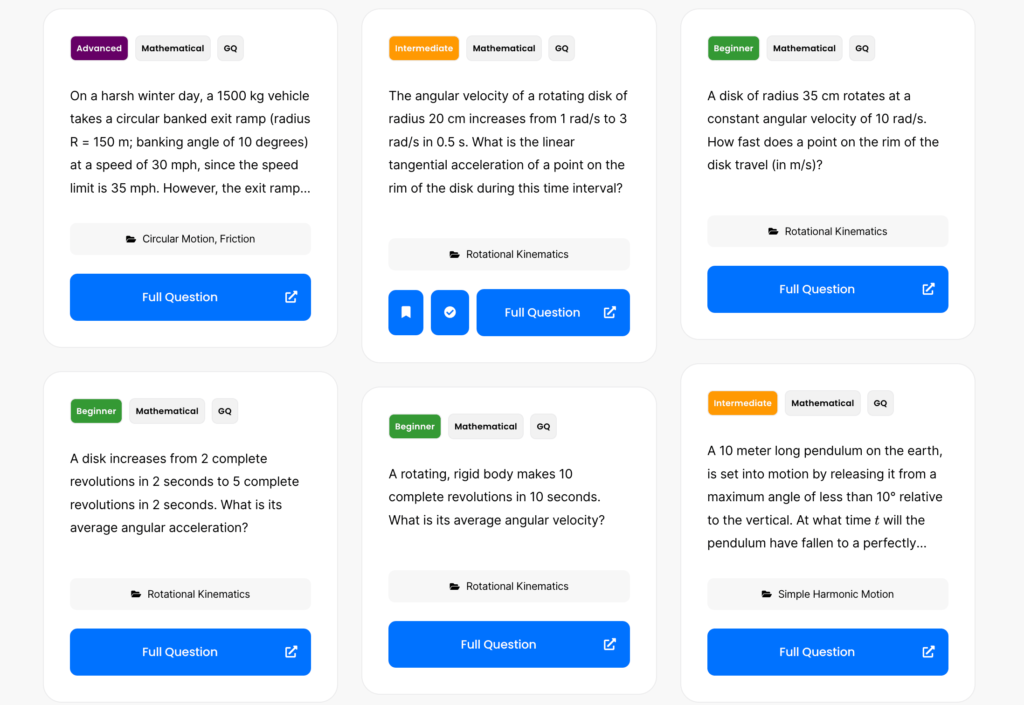0 attempts
0% avg
UBQ Credits
| Step | Calculation/Analysis | Description |
|---|---|---|
| 1 | [katex]T_{\text{max, stationary}} = m_{\text{operator}} \times g[/katex] | Maximum stationary tension with the operator’s weight. [katex]m_{\text{operator}} = 90 , \text{kg}, g = 9.81 , \text{m/s}^2[/katex]. |
| 2 | [katex]v = \frac{2\pi \times L}{T}[/katex] | Rotation speed calculation. [katex]L = 10 , \text{m}, T = 3 , \text{s}[/katex]. |
| 3.1 | [katex]T_{\text{horizontal}} = F_{\text{centripetal}}[/katex] | Horizontal component of tension equals centripetal force. |
| 3.2 | [katex]F_{\text{centripetal}} = \frac{m_{\text{child}} \times v^2}{r}[/katex] | Centripetal force formula. [katex]m_{\text{child}} = 25 , \text{kg}[/katex]. |
| 3.3 | [katex]r = L \sin(\theta)[/katex] | Effective radius related to the angle θ. |
| 3.4 | [katex]F_{\text{centripetal}} = \frac{m_{\text{child}} \times v^2}{L \sin(\theta)}[/katex] | Substitute [katex]r[/katex] in centripetal force formula. |
| 3.5 | [katex]T_{\text{vertical}} = m_{\text{child}} \times g[/katex] | Vertical component of tension equals child’s weight. |
| 3.6 | [katex]\tan(\theta) = \frac{T_{\text{horizontal}}}{T_{\text{vertical}}}[/katex] | Relation between tension components. |
| 3.7 | [katex]\tan(\theta) = \frac{m_{\text{child}} \times v^2 / (L \sin(\theta))}{m_{\text{child}} \times g}[/katex] | Substitute velocity and radius in the tangent formula. |
| 3.8 | [katex]cos\theta = \frac{9}{4\pi^2}[/katex] | Final, simplified equation |
| 3.9 | [katex]\theta = \approx 76.8 [/katex] | Approximate value of the angle to the vertical of any rider (angle does not depend of mass). |
| 4 | [katex]T_{\text{ride}}cos\theta = mg[/katex] | Solve for tension to get a total tension of ~ 1290 N for when the child sits in the seat. Remember the to add the mass of the seat to the child. |
| 5 | Safety Assessment | Tension in the chain is greater while child is rotating than when operator is sitting in it stationary, indicating the chain might break when the child is rotating in it. |
M
Just ask: "Help me solve this problem."
 The diagram above shows a marble rolling down an incline, the bottom part of which has been bent into a loop. The marble is released from point A at a height of \(0.80 \, \text{m}\) above the ground. Point B is the lowest point and point C the highest point of the loop. The diameter of the loop is \(0.35 \, \text{m}\). The mass of the marble is \(0.050 \, \text{kg}\). Friction forces and any gain in kinetic energy due to the rotating of the marble can be ignored. When answering the following questions, consider the marble when it is at point C.
The diagram above shows a marble rolling down an incline, the bottom part of which has been bent into a loop. The marble is released from point A at a height of \(0.80 \, \text{m}\) above the ground. Point B is the lowest point and point C the highest point of the loop. The diameter of the loop is \(0.35 \, \text{m}\). The mass of the marble is \(0.050 \, \text{kg}\). Friction forces and any gain in kinetic energy due to the rotating of the marble can be ignored. When answering the following questions, consider the marble when it is at point C.
Consider a neutron star with a mass equal to the sun, a radius of 10 km, and a rotation period of 1.0 s. What is the radius of a geosynchronous orbit about the neutron star? The mass of the sun can be found in the formula sheet above.
A rock is whirled on the end of a string in a horizontal circle of radius \(R\) with a constant period \(T\). If the radius of the circle is reduced to \(R/3\), while the period remains \(T\), what happens to the centripetal acceleration (\(a_c\)) of the rock?
A linear spring of negligible mass requires a force of \( 18.0 \, \text{N} \) to cause its length to increase by \( 1.0 \, \text{cm} \). A sphere of mass \( 75.0 \, \text{g} \) is then attached to one end of the spring. The distance between the center of the sphere \( M \) and the other end \( P \) of the un-stretched spring is \( 25.0 \, \text{cm} \). Then the sphere begins rotating at constant speed in a horizontal circle around the center \( P \). The distance \( P \) and \( M \) increases to \( 26.5 \, \text{cm} \).
Imagine a hypothetical planet that has two moons. Moon \(\#1\) is in a circular orbit of radius \(R\) and has a mass \(M\).
No it is not safe for the child. Based on the rotational speed, the child would be raised to an angle of ~77° from the initial vertical position. At this point the tension in the chain (~1290 N), while rotating, is considerable greater than the maximum force of tension (~920 N) the chain can with stand.
By continuing you (1) agree to our Terms of Use and Terms of Sale and (2) consent to sharing your IP and browser information used by this site’s security protocols as outlined in our Privacy Policy.
| Kinematics | Forces |
|---|---|
| \(\Delta x = v_i t + \frac{1}{2} at^2\) | \(F = ma\) |
| \(v = v_i + at\) | \(F_g = \frac{G m_1 m_2}{r^2}\) |
| \(v^2 = v_i^2 + 2a \Delta x\) | \(f = \mu N\) |
| \(\Delta x = \frac{v_i + v}{2} t\) | \(F_s =-kx\) |
| \(v^2 = v_f^2 \,-\, 2a \Delta x\) |
| Circular Motion | Energy |
|---|---|
| \(F_c = \frac{mv^2}{r}\) | \(KE = \frac{1}{2} mv^2\) |
| \(a_c = \frac{v^2}{r}\) | \(PE = mgh\) |
| \(T = 2\pi \sqrt{\frac{r}{g}}\) | \(KE_i + PE_i = KE_f + PE_f\) |
| \(W = Fd \cos\theta\) |
| Momentum | Torque and Rotations |
|---|---|
| \(p = mv\) | \(\tau = r \cdot F \cdot \sin(\theta)\) |
| \(J = \Delta p\) | \(I = \sum mr^2\) |
| \(p_i = p_f\) | \(L = I \cdot \omega\) |
| Simple Harmonic Motion | Fluids |
|---|---|
| \(F = -kx\) | \(P = \frac{F}{A}\) |
| \(T = 2\pi \sqrt{\frac{l}{g}}\) | \(P_{\text{total}} = P_{\text{atm}} + \rho gh\) |
| \(T = 2\pi \sqrt{\frac{m}{k}}\) | \(Q = Av\) |
| \(x(t) = A \cos(\omega t + \phi)\) | \(F_b = \rho V g\) |
| \(a = -\omega^2 x\) | \(A_1v_1 = A_2v_2\) |
| Constant | Description |
|---|---|
| [katex]g[/katex] | Acceleration due to gravity, typically [katex]9.8 , \text{m/s}^2[/katex] on Earth’s surface |
| [katex]G[/katex] | Universal Gravitational Constant, [katex]6.674 \times 10^{-11} , \text{N} \cdot \text{m}^2/\text{kg}^2[/katex] |
| [katex]\mu_k[/katex] and [katex]\mu_s[/katex] | Coefficients of kinetic ([katex]\mu_k[/katex]) and static ([katex]\mu_s[/katex]) friction, dimensionless. Static friction ([katex]\mu_s[/katex]) is usually greater than kinetic friction ([katex]\mu_k[/katex]) as it resists the start of motion. |
| [katex]k[/katex] | Spring constant, in [katex]\text{N/m}[/katex] |
| [katex] M_E = 5.972 \times 10^{24} , \text{kg} [/katex] | Mass of the Earth |
| [katex] M_M = 7.348 \times 10^{22} , \text{kg} [/katex] | Mass of the Moon |
| [katex] M_M = 1.989 \times 10^{30} , \text{kg} [/katex] | Mass of the Sun |
| Variable | SI Unit |
|---|---|
| [katex]s[/katex] (Displacement) | [katex]\text{meters (m)}[/katex] |
| [katex]v[/katex] (Velocity) | [katex]\text{meters per second (m/s)}[/katex] |
| [katex]a[/katex] (Acceleration) | [katex]\text{meters per second squared (m/s}^2\text{)}[/katex] |
| [katex]t[/katex] (Time) | [katex]\text{seconds (s)}[/katex] |
| [katex]m[/katex] (Mass) | [katex]\text{kilograms (kg)}[/katex] |
| Variable | Derived SI Unit |
|---|---|
| [katex]F[/katex] (Force) | [katex]\text{newtons (N)}[/katex] |
| [katex]E[/katex], [katex]PE[/katex], [katex]KE[/katex] (Energy, Potential Energy, Kinetic Energy) | [katex]\text{joules (J)}[/katex] |
| [katex]P[/katex] (Power) | [katex]\text{watts (W)}[/katex] |
| [katex]p[/katex] (Momentum) | [katex]\text{kilogram meters per second (kgm/s)}[/katex] |
| [katex]\omega[/katex] (Angular Velocity) | [katex]\text{radians per second (rad/s)}[/katex] |
| [katex]\tau[/katex] (Torque) | [katex]\text{newton meters (Nm)}[/katex] |
| [katex]I[/katex] (Moment of Inertia) | [katex]\text{kilogram meter squared (kgm}^2\text{)}[/katex] |
| [katex]f[/katex] (Frequency) | [katex]\text{hertz (Hz)}[/katex] |
General Metric Conversion Chart
Example of using unit analysis: Convert 5 kilometers to millimeters.
Start with the given measurement: [katex]\text{5 km}[/katex]
Use the conversion factors for kilometers to meters and meters to millimeters: [katex]\text{5 km} \times \frac{10^3 \, \text{m}}{1 \, \text{km}} \times \frac{10^3 \, \text{mm}}{1 \, \text{m}}[/katex]
Perform the multiplication: [katex]\text{5 km} \times \frac{10^3 \, \text{m}}{1 \, \text{km}} \times \frac{10^3 \, \text{mm}}{1 \, \text{m}} = 5 \times 10^3 \times 10^3 \, \text{mm}[/katex]
Simplify to get the final answer: [katex]\boxed{5 \times 10^6 \, \text{mm}}[/katex]
Prefix | Symbol | Power of Ten | Equivalent |
|---|---|---|---|
Pico- | p | [katex]10^{-12}[/katex] | 0.000000000001 |
Nano- | n | [katex]10^{-9}[/katex] | 0.000000001 |
Micro- | µ | [katex]10^{-6}[/katex] | 0.000001 |
Milli- | m | [katex]10^{-3}[/katex] | 0.001 |
Centi- | c | [katex]10^{-2}[/katex] | 0.01 |
Deci- | d | [katex]10^{-1}[/katex] | 0.1 |
(Base unit) | – | [katex]10^{0}[/katex] | 1 |
Deca- or Deka- | da | [katex]10^{1}[/katex] | 10 |
Hecto- | h | [katex]10^{2}[/katex] | 100 |
Kilo- | k | [katex]10^{3}[/katex] | 1,000 |
Mega- | M | [katex]10^{6}[/katex] | 1,000,000 |
Giga- | G | [katex]10^{9}[/katex] | 1,000,000,000 |
Tera- | T | [katex]10^{12}[/katex] | 1,000,000,000,000 |
The most advanced version of Phy. 50% off, for early supporters. Prices increase soon.
per month
Billed Monthly. Cancel Anytime.
Trial –> Phy Pro
We crafted THE Ultimate A.P Physics 1 course so you can learn faster and score higher.
Try our free calculator to see what you need to get a 5 on the upcoming AP Physics 1 exam.
A quick explanation
Credits are used to grade your FRQs and GQs. Pro users get unlimited credits.
Submitting counts as 1 attempt.
Viewing answers or explanations count as a failed attempts.
Phy gives partial credit if needed
MCQs and GQs are are 1 point each. FRQs will state points for each part.
Phy customizes problem explanations based on what you struggle with. Just hit the explanation button to see.
Understand you mistakes quicker.

Phy automatically provides feedback so you can improve your responses.
10 Free Credits To Get You Started

By continuing you agree to nerd-notes.com Terms of Service, Privacy Policy, and our usage of user data.
NEW! PHY AI accurately solves all questions
🔥 Get up to 30% off Elite Physics Tutoring
🧠 NEW! Learn Physics From Scratch Self Paced Course
🎯 Need exam style practice questions?